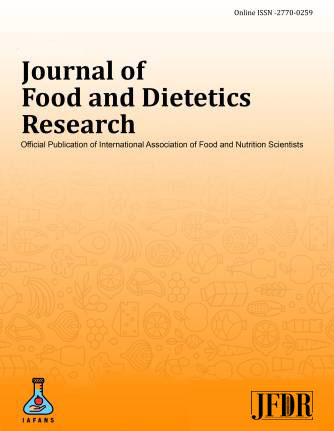Microbial quality and safety of ready-to-eat street-vended foods sold in selected locations in Kenya
DOI:
https://doi.org/10.48165/JFDR.2021.1202Keywords:
Food Safety, Hygiene, Microbial contamination, Pathogenic microorganisms, Ready-to-eat foods, Street-vended foodsAbstract
Objectives: Street-vended foods (SVFs) are a major contributor to foodborne diseases, especially in developing countries, where their sale is largely uncontrolled. Foodborne diseases have often been linked to high morbidity and mortality in some developing countries such as Kenya, demonstrating their public health and societal significance. The objective of this study was to determine the microbial quality and safety of ready-to-eat (RTE) foods sold in selected locations within Thika town in Kiambu County, Kenya.
Material and Methods: A total of 199 food samples consisting of cereals, sliced fruits, salads, groundnuts, tubers, fruit juices, boiled deshelled eggs, smokies, and sausages were randomly collected for microbial analysis. Determination of total viable count (TVC), total coliform count (TCC), yeast and molds count (YMC), Escherichia coli counts, Staphylococcus aureus counts as well as the presence of Salmonella spp., and Listeria monocytogenes were determined following standard microbiological methods.
Results: Results revealed that plant-based foods had significantly (P < 0.01) higher TVC, TCC, YMC, and S. aureus counts compared to animal-based foods. The levels of TVC, TCC, YMC, E. coli, and S. aureus ranged from 6.590 ± 1.020 to 3.377 ± 1.764, 5.567 ± 2.233 to 1.594 ± 2.299, 5.052 ± 1.201 to 1.595 ± 2.146, 2.033 ± 1.229 to 0.000 ± 0.000, and 5.972 ± 1.170 to 1.888 ± 1.660 Log10 CFU/g, respectively. At least nine food samples were contaminated with E. coli although the chance for contamination was significantly (P = 0.0002) higher (15 times) in plant-based foods compared to animal-based foods. At least one sample in each food type was contaminated with S. aureus with contamination levels above 1.888 ± 1.660 Log10 CFU/g. Salmonella spp. was only detected in boiled arrowroots (25%), boiled deshelled eggs (5.6%), French fries (5.6%), juices (5.0%), and cereals (11.1%), while L. monocytogenes were not detected in any food sample.
Conclusion: These findings demonstrate that RTE SVFs sold in this region constitute a potential health hazard to consumers because of the presence of Salmonella spp., and high counts of E. coli and S. aureus. These foods are, therefore, microbiologically unsafe and unsuitable for human consumption as they may cause foodborne disease outbreaks.




